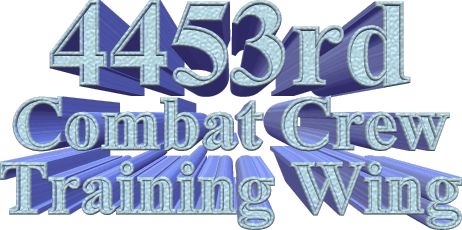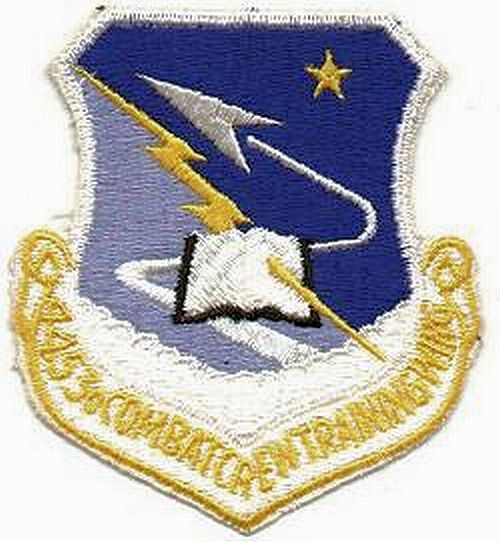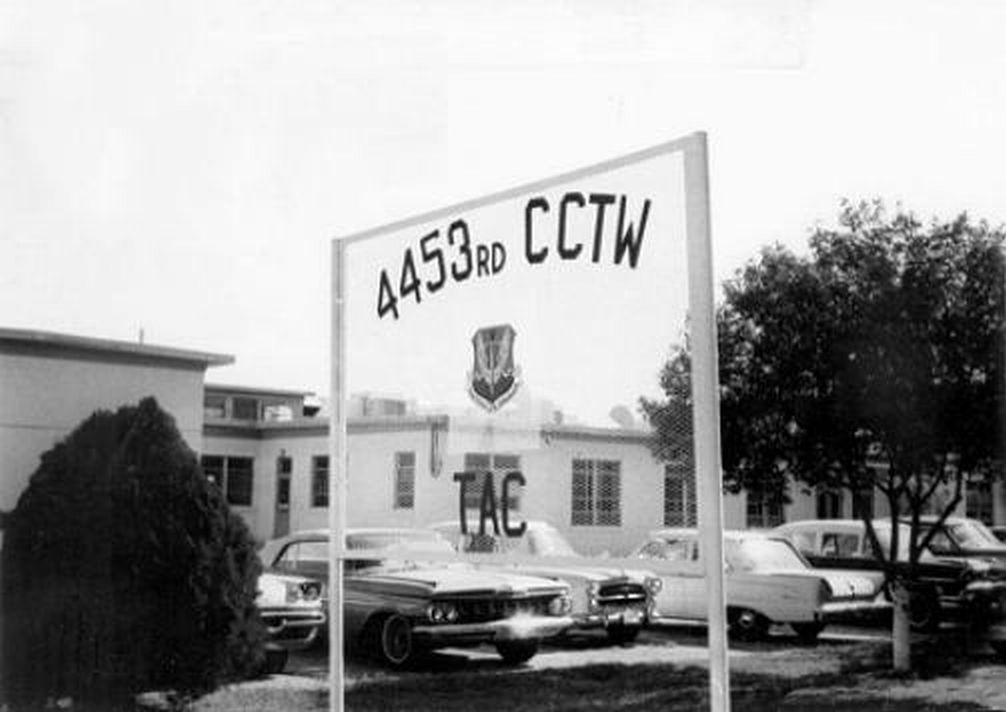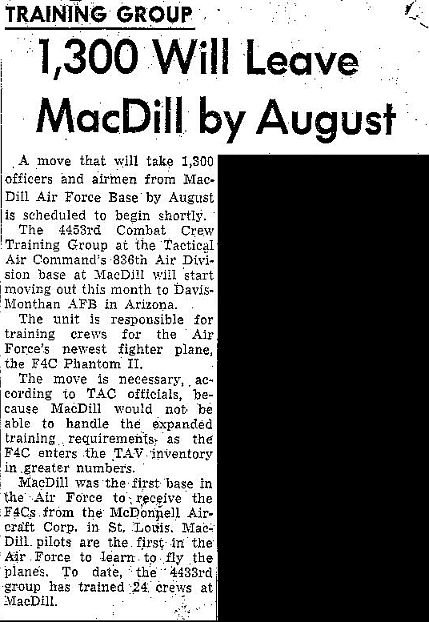


The 4453rd activated on Oct 22, 1962 at MacDill AFB in Tampa, Florida. It was called the 4453rd Combat Crew Training Squadron.
On Jan 1, 1964, we became the 4453rd Combat Crew Training Group.
Finally, on April, 1, 1964, we were large enough to become the 4453rd Combat Crew Training Wing. We were part of the 836th Air Division.

On July 1, 1964, we became part of the 12th Air Force. Our mission was to train aircrews for the F4.
We received 27 Navy F4B's, the first aircraft was delivered on February 11,1963. It was crewed by Col Stanton T. Smith, then Commander of the 836th Air Division and Major Jerry F. Hogue. These aircraft had Navy serial numbers as well as Air Force serial numbers.
References show the Air Force received 29 F4B's from the Navy. The additional 2 aircraft were sent to Langley AFB. Although they received the Air Force paint scheme and had F110A painted on the forward fuselage, they were not F110s. They displayed the Navy serial numbers on their rudders. The BuNos on these aircraft were 149405 and 149406 and the identifiers FJ-405 and FJ-406 were used. Later, they were given Air Force serial numbers 62-12168 and 62-12169 respectively. There were also test aircraft at Edwards AFB and others. The serial numbers on these aircraft were 408 through 410.
--------------------------------------------------------------------------------
4453rd CCTW History
--------------------------------------------------------------------------------
I would like to thank Lee R. DeHaven for the following 4453rd CCTW history. Some additional information has been contributed by Tom Pirtle. We know this in not complete and may contain some errors. If you have any additional information or corrections to the 4453rd CCTW history please let us know and we will add it here.
--------------------------------------------------------------------------------
Organizational Dates
4453rd Combat Crew Training Squadron (CCTS) 22 Oct 1962 - 1 Jan 1964
4453rd Combat Crew Training Group (CCTG) 1 Jan 1964 - 1 Apr 1964
4457th CCTS original squadron
4458th CCTS original squadron
Reorganized with the following squadrons on 17 Dec 1963
4454th CCTS operational squadron 1 Jan 1964 - 16 Aug 1971
4455th CCTS operational squadron 1 Jan 1964 - 30 Sep 1971
4456th CCTS operational squadron 1 Jan 1964 - 30 Jul 1971
4457th CCTS academic squadron 1 Jan 1964 - xx xxx 1971
4453rd Combat Crew Training Wing (CCTW) 1 Apr 1964 - 30 Sep 1971
Retained the above 4 squadrons
The 4472nd CCTS (DC-130A drone carrier) operated 10 Jul 1968 - 1 Jul 1969.
Redesignated the 4472nd Support Squadron (special projects activity) and coded
within the 4453rd CCTW 1 Jul 1969 - 1 Jul 1971
Bases
MacDill AFBÂ Tampa, Florida 1 Jan 1963 - 8 Jan 1964
Davis-Monthan AFBÂ Tucson, Arizona 8 Jan 1964 - 30 Sep 1971
Commands
836th Air Division, 9th Air Force 1 Jan 1963 - 1 Jul 1964
12th Air Force 1 Jul 1964 - 30 Sep 1971
Aircraft Models
F-4B 1963 - 1964
F-4C 1963 - 1971
F-4D 1966 - 1971
--------------------------------------------------------------------------------
TAC's Top Team
Desert Airman - 12 Feb 1965
Davis-Monthan AFB
'TAC's Top Team' 4453rd Receives IG Rating of 'Outstanding'
by Capt. Harry E. Ramsay
"Best in the West and Twelfth Air Force" were Col. Marion F. Caruthers' closing comments to Col. Frank K. Everest Jr. at Monday's 12th AF Inspector General's (IG) critique of the 4453rd Combat Crew Training Wing. Colonel Caruthers, team chief for the 12th AF inspection team, arrived with his inspection party last week for the first 12AF inspection of the 4453rd CCTW. After a thorough and comprehensive five days of inspection, the IG team rated the 4453rd "OUTSTANDING." Colonel Caruthers further stated, "This is the first 12th AF unit to receive an overall rating of Outstanding."A further check with Tactical Air Command Headquarters at Langley AFB,Va., indicated that the "Outstanding" rating has not been awarded to a Tactical Air Command regular or reserve wing since 1961.
Colonel Everest lauded each officer and airman in his wing. "I want every officer and airman of the 4453rd Combat Crew Training Wing to know that without their professional attention to duty, such a high rating would not have been possible. "Particular note was given to all 4453rd Combat Crew Training Squadron commanders for their "leadership and professionalism." Colonel Everest further singled out the wing deputy commander for material, Col. Thomas E. Stewart, "as one man whose efforts were very instrumental in the high rating." Colonel Everest has declared Monday, Feb. 15 an "IG Holiday" for all military personnel of the 4453rd. When you see a TAC man holding his head higher during the next few days, you will know he belongs to "TAC's Top Team."
--------------------------------------------------------------------------------
The Airman Magazine - April 1964
"Burn up the Sky"
4453rd CCTW and 12th TFW
While McDonnell was tooling up for modifications to the TAC version of the Phantom, the Air Force "borrowed" 27 F4B's from the Navy and began training. Colonel Hogue delivered the first F4B to MacDill AFB, Fla., February 11, 1963. In the meantime, 13 instructor pilots had been trained by the Navy at Oceana NAS. These returned to MacDill to train other instructors in the 4453rd Combat Crew Training Squadron, which had been set up to conduct F4 training. One of the first 4453rd pilots to be checked out by Colonel Hogue was its commander, Col. Frank K. Everest, Jr. ........
Colonel Everest called the F4 a fighter pilot's dream. "Our pilots should take to the F4C with pleasure," he said. "It's an easier plane to fly than some fighters and its equipment is less complicated." The first organization in the Air Force to phase into the F4 is the 12th Tactical Fighter Wing, commanded by Col. Harold M. McClelland.........
The first F4 class was composed of 24 pilots assigned or attached to the 557th Tactical Fighter Squadron, commanded by Lt. Col. Mark V. Wilson. It is one of the four squadrons in the 12th. During the 11 week course, pilots compiled 30 flying hours in the Phantom. After two familiarization rides, the class was divided into 12 two man crews who practiced instruments, low-level and high-level navigation, radio and radar navigation, air to air intercepts, dive-bombing, rocketry, low-level bombing, close ground support, nuclear delivery, in-flight refueling, and formation. The fighter pilots learned to work as part of a two man team. The front seat pilot is the aircraft commander, who makes the landings and takeoffs, flies the aircraft, and handles the armament. The rear seat pilot, the pilot systems operator, also flies the aircraft but he must also operate the Phantom's sophisticated radar and navigation equipment.
Besides the ground school attended in conjunction with the 11 week, 30 flying hour course, pilot systems operators got an additional 250 hours of classroom work in radar and navigation. The first class graduated December 5, 1963, and the second one January 10, this year. (1964) All flying was done in the F4B the Navy training version of the Phantom.
Piloted by Brig. Gen. Gilbert L. Meyers, commander 836th Air Division, the first F4C arrived at MacDill on November 20, 1963........The 12th is now receiving the F4C's in quantity, and the wing is fast becoming the most powerful retaliatory force in Tactical Air Command.
Yet, even with the Phantom, it is doubtful that many TAC fighter pilots will be walking on water. But, as one young pilot said after his first Mach 2 run, "Who needs to? With this airplane, we'll burn up the sky!"

This is the History of the 4453rd as it was shown on the old 4453rd web page. I copied it as is. 1965 is missing.
1963
As the USAF was ramping up to take delivery of their first F-4 Phantom II the 4453rd CCTS was activated at MacDill AFB, Florida, to serve as the Phantom II transition unit. Activation activities spanned the period between 1 Jan. and 30 Jun. The squadron was organized and assigned to the USAF Combat Crew Training School, which was likewise activated at MacDill AFB on 1 Jan.
During this period the initial cadre of USAF transition aircrews were undergoing Phase I upgrade training, presumably via the U.S. Navy's Replacement Air Group (RAG) training squadrons, VF-101 at NAS Oceana, Virginia and VF-121 at NAS Miramar, California. Following completion of this transition training these pilots served as the Instructor Pilots (IP) for the first dedicated classes of USAF Phantom II aircrews. The maintenance personnel were likewise attending USN technical schools at these two Naval Air Stations and elsewhere. When this initial cadre of personnel returned to MacDill AFB they brought with them USN-style manuals which were used during the tenure of the USN F-4B and the early years with the USAF-ordered F-4C.
One of the given facts of service life is the inter-service rivalries--when USN personnel learned that the "land-lubbing Blue Suiters" would be arriving at Navy bases at least one suitable cartoon was created to commemorate the ceremony. Herman R. "Buck" Seibert, attending the J79 Technical School at NAS Miramar, recounts his encounter--
"Imagine our surprise when we found the following drawing on one of the first pages of the Navy Flight Manual. [see Humor on home page] Our Commander, Col. Frank Everest, had it enlarged and it hung behind his desk for quite a while. It shows two Air Force F-4's attempting to land on a carrier. The Captain has left the ship in his skiff and the crew is jumping overboard. Classic humor in uniform. I always wondered if this drawing was inserted only in the manual we received, or was in all the manuals including those issued to the Navy."
The mission of the 4453rd CCTS, as directed by the 836 Air Division (836 AD), was to give initial transition and instrument training for the F-4 and RF-4C aircraft instructor pilots and aircraft commanders. In addition, they were to train F/RF-4C aircrews to meet operational readiness dates of the converting tactical fighter units.
USN F-4B Inventory
The 4453rd CCTS hold the unique place in Phantom II history as the only USAF unit to actually equip with the Navy F-4B. The USAF-ordered F-4C would not be rolling off the St. Louis production line in time for initial training so the USAF "borrowed" 27 USN F-4B's fresh off the production line, with a few USAF-specific modifications, to equip the 4453rd CCTS.
On 4 Feb Col. Stanton T. Smith, Commander, 836 AD and Lt. Col. Jerry F. Hogue, Headquarters, TAC, ferried the first F-4B in from the production line to MacDill AFB. A total of 27 F-4B's were delivered between February and July.
By late in the year the issue of the aircraft traffic and ramp space became an issue. The 12th TFW and 15th TFW, both equipped with the F-84, had priority for facility assignments. The ramping up of the 4453rd CCTS was creating a genuine traffic jam. The over-crowding became bad enough that by July it was necessary for the new operating location for the 4453rd CCTS to be established. Davis-Monthan AFB, Arizona, was selected and preparations got under way for the move.
A rare treat for the troops was enjoyed on 18 Nov when President John F. Kennedy paid a visit to MacDill AFB.
First F-4C
The first two USAF-ordered F-4C's arrived on 20 November. BGen. Gilbert L. Meyers, Commander, 836 AD and Col. Frank K. "Pete" Everest, Commander, 4453rd CCTS, were at the controls of F-4C's 63-7415 and 63-7416. Lt. Gen. Charles B. Westover, Vice Commander, TAC, was on hand to formally accept on behalf of TAC, these aircraft. Tragically the President was assassinated only days later--the first official mission for the 4453rd CCTS aircrews was to take part in the military fly-over at the State funeral.
After eleven weeks of intensive training the first class of twenty-four USAF F-4 Pilot / Pilot System Operator (PSO) graduated on 6 December. The graduation ceremony was attended by Gen. Walter C. Sweeney, Jr., Commander, TAC, and BGen. Gilbert L. Myers, Commander, 836 AD. Following a tight diamond formation fly-by and personnel review, Gen Sweeney presented the aircrewmen with certificates and hearty "Well Done" congratulations on becoming the USAF's first Phantom drivers.
Four additional F-4C's were received in December for a year-end inventory of 27 F-4B and 6 F-4C. The squadron reached Initial Operational Capability (IOC) in the F-4C in December.
To prepare for the move TAC issued orders redesignating and reorganizing the squadron from the 4453rd CCTS to the 4453rd CCTG to be effective 1 Jan 1964. This reorganizing involved organizing two new squadrons, the 4457th CCTS and 4458th CCTS. However, even before the time arrived TAC issued a second set of reorganizing orders on 17 Dec 1963, dropping the 4457th and 4458th CCTS, in favor of four new squadrons, the 4454th, 4455th, 4456th and 4457th CCTS's, effective 1 January.
F-4C 63-7418 was assigned to the unit in January to serve as the "lead-the-force" aircraft, that is, an aircraft that flies an accelerated schedule to evaluate the aircraft and it's diferent systems sooner that would be possible under normal scheduling conditions. While assigned to the unit 63-7418 was the first USAF F-4 to reach 1,000 flight hours, the first to reach the 2,000 flight hour mark (circa December 1967), via approximately 1,200 missions--the equivalent of flying non-stop for 83 days during which the aircraft traveled 1,000,000 miles / 1,609,300 km (40 trips around the globe). Making the 2,000th flight hour was Lt. Col. John C. Holley, 4455 CCTS Commander, pilot, with the aircrafts's crew chief, non-pilot Sgt. Herbert Bencosky.
The actual move to Davis-Monthan AFB begain effective 8 January. Based at MacDill AFB the four CCTS squadrons took delivery of new production F-4C's, relieving the need for the USN F-4B's, which were returned to the Navy as the F-4C's arrived (likely a one-for-one transfer).
The first strike occurred on 22 May when Capt. Joseph P. Onate and Capt. William F. Buhrman were killed in the crash of 63-7416 at the Avon Park Bombing Range, Florida.
1966
In March the Wing's Organizational Maintenance Squadron (OMS) "A" Section introduced a unique maintenance program which was to be "tested" through April of 1967. Following up on a request from higher up the Continuous Inspection Cycle (CIC) was developed by Wing maintenance personnel--basically the CIC system involved rescheduling inspections to occur during the aircraft's normal down time and in "modules." If a panel were to be removed to repair / inspect a component then all other components behind the panel were to be inspected as part of the routine inspection process. The CIC system replaced the then-standard method of conducting these routine inspections at the 300 flying hour checks. Results from the CIC test program reduced the length of inspection time from 11 day down to 4-1/2 days at the 300 hour mark. During one month shortly after implementation of the CIC reportedly saved the Wing 15,000 maintenance man-hours, reducing the maintenance man-hours per flying hour to only 19 hours.
The F-4D was added to the inventory during the spring.
On 21 May F-4C 64-0809, crashed near Davis-Monthan AFB. Lt. R.A. Nester made a successful ejection. On 16 September F-4C 63-7627 crashed near Gila Bend, Arizona. (Looks like crew was killed)
Until recently the Wing had been focusing on training USAF aircrews in basic flying characteristics of the F-4 for aircrewmen transitioning from other aircraft types. However, circa September, due to combat needs in Southeast Asia, the Wing reconfigured the curriculum into a much longer course that brought the aircrews up to speed, sufficiently so that the men could be transferred directly to a combat wing based in Southeast Asia. The new course added dogfighting (informally referred to as "hossling"), dive bombing, strafing and other air to ground ordinance delivery tactics.
A visitor from "down under" was assigned during November. Squadron Leader Frederick M. Kinvig, New Zealand Air Force, was an exchanged pilot serving as an F-4C instructor Pilot for the 4453rd CCTW.
1967
The British Royal Air Force (RAF) was in the process of ramping up for delivery of their F-4M / FGR.2. The initial cadre of Instructor Pilots received their transition training in the U.S. in late 1967 / early 1968.
On 19 December F-4D 66-7744 crashed while taking off from Davis-Monthan AFB.
1968
In January issue of the Phantom NEWSLETTER, there was an article about a USAF first--a father and son receiving the same USAF training at the same base at the same time. The father, Col. Lee H. Batsel, Assistant Deputy Commander for Operations, 41st Air Division, Yokota Air Base, Japan. The son, 2Lt. Michael L. Batsel, a September graduate from Pilot Training School, Vance AFB, Oklahoma, and currently assigned to a unit at Homestead AFB, Florida.
The where--both men arrived at Davis-Monthan AFB, Arizona, and checked in at the 4453rd CCTW where Col. Batsel was attending a one month familiarization program of the F-4C. 2Lt. Batsel attended the academic program prior to returning to Homestead AFB to finish his flight training in the F-4C. On Col. Batsel's fifth sortie in the F-4C he had his son in the backseat, the first time in about sixteen years that the two had been flying together. This was at the time believed to been a USAF "first."
On 28 June F-4C 63-7458 crashed.
In either late 1968 or early 1969 five sets of aircrews from the Israeli Air Force (IAF) checked in with the 4453rd CCTW for basic F-4 transition training. All of the IAF aircrewmen were combat veterans and as the stories go, there is a debate over who actually taught whom what in the F-4. The IAF aircrews were experiencing the two-man team arrangement for the first time but their collective combat experience against a more active foe than the limited USAF engagements with the North Vietnamese Air Force (NVAF) gave them experience with tactics considered saftey risks by the USAF IP's (themselves just learning the aircraft). Following the initial transition training the IAF element transferred to George AFB, California, for more advanced training.
1969
On 29 January McAir received a Change Order authorizing the go-ahead on constructing and testing the Boron Epoxy Rudder on the F-4. On 10 December McAir shipped five Boron Epoxy Rudders to Davis-Monthan AFB for installation and testing on operational aircraft over the next few years. After three years of operational testing three rudders were removed and returned to McAir for structural tests to determine the effect on integrity due to environmental exposure.
1970
On 24 July F-4C 63-7609 crashed.
1971
In February the Wing was tasked with providing familiarization training (FAM) for eight Spanish Air Force (SAF) instructor pilots in preparations of the SAF taking delivery of 36 surplus F-4C's.
On 17 February F-4C 64-7476 crashed.
Wing Deactivation
The inactivation of the 4453rd CCTW was set and the draw down with the inactivation's of the 4456th CCTS on 30 July, the 4454th CCTW on 16 August and the 4455th CCTS on 30 September. The 4457th CCTS was deactivated in this time frame. The Wing officially stood down on 30 September.
The F-4 operations were reassigned to the 58th TFTW at Luke AFB, AZ. The F-4C assets were used to form the 310th, 426th and 550th TFTS / 58th TFTW. The switch brought the A-7D Corsair II to Davis-Monthan AFB with the reactivation of the 355th TFW on 1 July 1971. The 4453rd CCTW operated along side the 355th TFW (actually the same personnel) until the transfer to Luke AFB was completed and deactivation on 30 Sept. 1971. Most of the former 4453rd personnel stayed at DM with the 355th TFW.
There has long been a debate among historians about whether or not the 4453rd CCTW was, as a Wing, actually attached to the 355th TFW, effective 1 July. The 355th TFW history lists the 4453rd CCTW as attached 1 July through 30 September.
The 4453rd CCTW also had the 4472nd CCTS which operated the DC-130A drone carrier. It was redesignated the 4472nd Support Squadron (Special Projects Activity) on 1 Jul 1969 when it was coded within the 4453rd CCTW. The 4472nd CCTS was replaced with the 11th Tactical Drone Squadron (TDS) of the 355th TFW on 1 July with the deactivation of the 4453rd CCTW.
4453rd CCTW Guide Article - 1969
Courtesy of Alan Cooper
